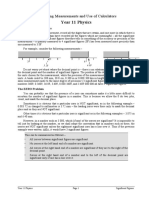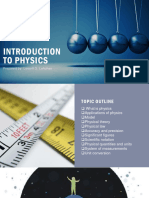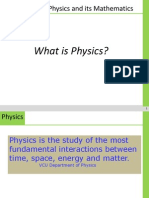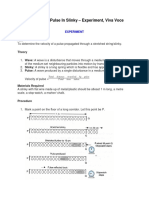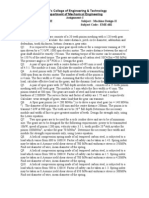Introduction To Physics
Introduction To Physics
Uploaded by
Nana Ama Donkor-boatengCopyright:
Available Formats
Introduction To Physics
Introduction To Physics
Uploaded by
Nana Ama Donkor-boatengOriginal Title
Copyright
Available Formats
Share this document
Did you find this document useful?
Is this content inappropriate?
Copyright:
Available Formats
Introduction To Physics
Introduction To Physics
Uploaded by
Nana Ama Donkor-boatengCopyright:
Available Formats
Introduction to Physics To begin the study of physics, you must first understand what the phrase itself means.
Understanding what falls within the realm of physics - and what does not - helps focus the field of study so that you can formulate meaningful physics questions. What is Physics? Fields of Physics Physics Dictionary Introduction to the Scientific Method Hypothesis, Model, Theory, & Law Popular Physics Myths Grand Ideas of Science The 5 Great Problems in Theoretical Physics Mathematics & Other Physics Tools
The tools that physicists use range from the physical to the abstract, from balance scales to laser beam emitters to mathematics. Understanding this wide range of tools and the methods for applying them is essential to understanding the process that physicists go through in studying the physical world. Using Significant Figures & Scientific Notation Metric System - the International System of Measurements Introduction to Vector Mathematics Mathematical Properties of Waves Fundamental Physics Discoveries & Laws
The goal of physics is to develop precise models of physical reality. The best case scenario is to develop a series of very fundamental rules to describe how these models function ... rules which are frequently called "laws," after they have been used successfully for many years. Major Laws of Physics
Newton's Laws of Motion Newton's Law of Gravity Laws of Thermodynamics Quantum Physics Fundamentals of Particle Physics Einstein's Theory of Relativity History of Physics & Famous Physicists
Physics does not exist in a vacuum, of course (though some physics is practiced in a vacuum). The forces of history have shaped the development of physics as much as any other field in history, and it is often useful to understand the historical perspectives which have lead us to our current understanding ... including the many incorrect paths that were faltered along for far too long. It is also useful and intriguing to learn about the lives of the famous physicists of the past. Physics of the Greeks Galileo Galilei Sir Isaac Newton Albert Einstein Niels Bohr Richard P. Feynman Stephen Hawking
Introducing Significant Figures When making a measurement, a scientist can only reach a certain level of precision, limited either by the tools being used or the physical nature of the situation. The most obvious example is measuring distance. Consider what happens when measuring the distance an object moved using a tape measure (in metric units). The tape measure is likely broken down into smallest units of millimeters. Therefore, there's no way that you can measure with a precision greater than a millimeter. If the
object moves 57.215493 millimeters, therefore, we can only tell for sure that it moved 57 millimeters (or 5.7 centimeters or 0.057 meters, depending on the preference in that situation). In general, this level of rounding is fine. Getting the precise movement of a normal sized object down to a millimeter would be a pretty impressive achievement, actually. Imagine trying to measure the motion of a car to the millimeter, and you'll see that in general this isn't necessary. In the cases where such precision is necessary, you'll be using tools that are much more sophisticated than a tape measure. The number of meaningful numbers in a measurement is called the number of significant figures of the number. In our earlier example the 57 millimeter answer would provide us with 2 significant figures in our measurement. Zeroes & Significant Figures Consider the number 5,200. Unless told otherwise, it is generally the common practice to assume that only the two non-zero digits are significant. In other words, it is assumed that this number was rounded to the nearest hundred. However, if the number is written as 5,200.0, then it would have five significant figures. The decimal point and following zero is only added if the measurement is precise to that level. Similarly, the number 2.30 would have three significant figures, because the zero at the end is an indication that the scientist doing the measurement did so at that level of precision. Some textbooks have also introduced the convention that a decimal point at the end of a whole number indicates significant figures as well. So 800. would have three significant figures while 800 has only one significant figure. Again, this is somewhat variable depending on the textbook. Following are some examples of different numbers of significant figures, to help solidify the concept: One significant figure 4 900 0.00002 Two significant figures 3.7
0.0059 68,000 5.0 Three significant figures 9.64 0.00360 99,900 8.00 900. (in some textbooks) Mathematics with Significant Figures Scientific figures provide some different rules for mathematics than what you are introduced to in your mathematics class. The key in using significant figures is to be sure that you are maintaining the same level of precision throughout the calculation. In mathematics, you keep all of the numbers from your result, while in scientific work you frequently round based on the significant figures involved. When adding or subtracting scientific data, it is only last digit (the digit the furthest to the right) which matters. For example, let's assume that we're adding three different distances: 5.324 + 6.8459834 + 3.1 The first term in the addition problem has four significant figures, the second has eight, and the third has only two. The precision, in this case, is determined by the shortest decimal point. So you will perform your calculation, but instead of 15.2699834 the result will be 15.3, because you will round to the tenths place (the first place after the decimal point), because while two of your measurements are more precise the third can't tell you anything more than the tenths place, so the result of this addition problem can only be that precise as well. Note that your final answer in this case has three significant figures, while none of your starting numbers did. This can be very confusing to beginning students, and it's important to pay attention to that property of addition and subtraction. When multiplying or dividing scientific data, on the other hand, the number of significant figures do matter. Multiplying significant figures will always result in a solution that has the same significant figures as the smallest significant figures you started with. So, on to the example:
5.638 x 3.1 The first factor has four significant figures and the second factor has two significant figures. Your solution will, therefore, end up with two significant figures. In this case, it will be 17 instead of 17.4778. You perform the calculation then round your solution to the correct number of significant figures. The extra precision in the multiplication won't hurt, you just don't want to give a false level of precision in your final solution. Physics deals with realms of space from the size of less than a proton to the size of the universe. As such, you end up dealing with some very large and very small numbers. Generally, only the first few of these numbers are significant. No one is going to (or able to) measure the width of the universe to the nearest millimeter. NOTE: This portion of the article deals with manipulating exponential numbers (i.e. 105, 10-8, etc.) and it is assumed that the reader has a grasp of these mathematical concepts. Though the topic can be tricky for many students, it is beyond the scope of this article to address. In order to manipulate these numbers easily, scientists use scientific notation. The significant figures are listed, then multiplied by ten to the necessary power. The speed of light is written as: [blackquote shade=no]2.997925 x 108 m/s There are 7 significant figures and this is much better than writing 299,792,500 m/s. (NOTE: The speed of light is frequently written as 3.00 x 108 m/s, in which case there are only three significant figures. Again, this is a matter of what level of precision is necessary.) This notation is very handy for multiplication. You follow the rules described earlier for multiplying the significant numbers, keeping the smallest number of significant figures, and then you multiply the magnitudes, which follows the additive rule of exponents. The following example should help you visualize it: 2.3 x 103 x 3.19 x 104 = 7.3 x 107 The product has only two significant figures and the order of magnitude is 107 because 103 x 104 = 107 Adding scientific notation can be very easy or very tricky, depending on the situation. If the terms are of the same order of magnitude (i.e. 4.3005 x 105 and 13.5 x 105), then you follow the addition rules discussed earlier, keeping the highest place value as your rounding location and keeping the magnitude the same, as in the following example: 4.3005 x 105 + 13.5 x 105 = 17.8 x 105 If the order of magnitude is different, however, you have to work a bit to get the magnitudes the same, as in the following example, where one term is on the magnitude of 105 and the other term is on the magnitude of 106:
4.8 x 105 + 9.2 x 106 = 4.8 x 105 + 92 x 105 = 97 x 105 or 4.8 x 105 + 9.2 x 106 = 0.48 x 106 + 9.2 x 106 = 9.7 x 106 Both of these solutions are the same, resulting in 9,700,000 as the answer. Similarly, very small numbers are frequently written in scientific notation as well, though with a negative exponent on the magnitude instead of the positive exponent. The mass of an electron is: 9.10939 x 10-31 kg This would be a zero, followed by a decimal point, followed by 30 zeries, then the series of 6 significant figures. No one wants to write that out, so scientific notation is our friend. All the rules outlined above are the same, regardless of whether the exponent is positive or negative. The Limits of Significant Figures Significant figures are a basic means that scientists use to provide a measure of precision to the numbers they are using. The rounding process involved still introduces a measure of error into the numbers, however, and in very high-level computations there are other statistical methods that get used. For virtually all of the physics that will be done in the high school and college level classrooms, however, correct use of significant figures will be sufficient to maintain the required level of precision. Final Comments Significant figures can be a significant stumbling block when first introduced to students, because it alters some of the basic mathematical rules that they have been taught for years. With significant figures, 4 x 12 = 50, for example. Similarly, the introduction of scientific notation to students who may not be fully comfortable with exponents or exponential rules can also create problems. Keep in mind that these are tools which everyone who studies science had to learn at some point, and the rules are actually very basic. The trouble is almost entirely remembering which rule is applied at which time. When do I add exponents and when do I subtract them? When do I move the decimal point to the left and when to the right? If you keep practicing these tasks, you'll get better at them until they become second nature. Finally, maintaining the proper units can be tricky. Remember that you can't directly add centimeters and meters, for example, but must first convert them into the same scale. This is a very common mistake for beginners but, like the rest, it is something that can very easily be overcome by slowing down, being careful, and thinking about what you're doing.
About Physical Laws: Over the years, one thing scientists have discovered is that nature is generally more complex than we give it credit for. The following laws of physics are considered fundamental, but many of them refer to idealized, closed systems, which are hard to obtain in the real world. Also, some are altered slightly in different circumstances. The laws that Newton developed, for example, are modified by the findings of the theory of relativity, but they are still basically valid in most regular cases that you'll run into. Newton's Three Laws of Motion: Sir Isaac Newton developed the Three Laws of Motion, which describe basic rules about how the motion of physical objects change. Newton was able to define the fundamental relationship between the acceleration of an object and the total forces acting upon it. "Law" of Gravity: Newton developed his "Law of Gravity" to explain the attractive force between a pair of masses. In the twentieth century, it became clear that this is not the whole story, as Einstein's theory of general relativity has provided a more comprehensive explanation for the phenomenon of gravity. Still, Newton's law of gravity is an accurate low-energy approximation that works for most of the cases that you'll explore in physics. Conservation of Mass-Energy: The total energy in a closed or isolated system is constant, no matter what happens. Another law stated that the mass in an isolated system is constant. When Einstein discovered the relationship E=mc2 (in other words that mass was a manifestation of energy) the law was said to refer to the conservation of mass-energy. The total of both mass and energy is retained, although some may change forms. The ultimate example of this is a nuclear explosion, where mass transforms into energy. Conservation of Momentum: The total momentum in a closed or isolated system remains constant. An alternative of this is the law of conservation of angular momentum. Laws of Thermodynamics: The laws of thermodynamics are actually specific manifestations of the law of conservation of mass-energy as it relates to thermodynamic processes. The zeroeth law of thermodynamics makes the notion of temperature possible. The first law of thermodynamics demonstrates the relationship between internal energy, added heat, and work within a system.
The second law of thermodynamics relates to the natural flow of heat within a closed system. The third law of thermodynamics states that it is impossible to create a thermodynamic process which is perfectly efficient. The zeroeth law of thermodynamics makes the notion of temperature possible. The first law of thermodynamics demonstrates the relationship between internal energy, added heat, and work within a system. The second law of thermodynamics relates to the natural flow of heat within a closed system. The third law of thermodynamics states that it is impossible to create a thermodynamic process which is perfectly efficient. Electrostatic Laws: Coulomb's law and Gauss's law are formulations of the relationship between electrically charged particles to create electrostatic force and electrostatic fields. The formulas, it turns out, parallel the laws of universal gravitation in structure. There also exist similar laws relating to magnetism and electromagnetism as a whole. Invariance of the Speed of Light: Einstein's major insight, which led him to the Theory of Relativity, was the realization that the speed of light in a vacuum is constant and is not measured differently for observers in different inertial frames of reference, unlike all other forms of motion. Some theoretical physicists have conjectured different variable speed of light (VSL) possibilities, but these are highly speculative. Most physicists believe that Einstein was right and the speed of light is constant. Modern Physics & Physical Laws: In the realm of relativity and quantum mechanics, scientists have found that these laws still apply, although their interpretation requires some refinement to be applied, resulting in fields such as quantum electronics and quantum gravity. Care should be taken in applying them in these situations.
You might also like
- Electronic Factors Determining The Reactivity of Metal SurfacesDocument10 pagesElectronic Factors Determining The Reactivity of Metal SurfacesLuca BrunoNo ratings yet
- Important Trick To Remember All Thermodynamic Cycles For Oral ExamsDocument11 pagesImportant Trick To Remember All Thermodynamic Cycles For Oral ExamsParikshit Ugale50% (2)
- Bulk Specific Gravity and Density of Non-Absorptive Compacted Asphalt MixturesDocument4 pagesBulk Specific Gravity and Density of Non-Absorptive Compacted Asphalt MixturesAshraf Tomizeh100% (1)
- Double WedgeDocument9 pagesDouble WedgeKarthick MurugesanNo ratings yet
- Star CCM+: 3D-CAD ModelerDocument4 pagesStar CCM+: 3D-CAD ModelerlukhmanNo ratings yet
- Laboratorymanual 135ALDocument182 pagesLaboratorymanual 135ALmollinedopinonNo ratings yet
- Chap 1Document50 pagesChap 1api-30718309No ratings yet
- Summer Assignment Part II Notes: CIA World Factbook 2007 Russ Rowlett's UNC GuideDocument6 pagesSummer Assignment Part II Notes: CIA World Factbook 2007 Russ Rowlett's UNC GuideJingyi ZhouNo ratings yet
- How To Write A Lab ReportDocument6 pagesHow To Write A Lab ReportmohoNo ratings yet
- Physics Lecture On MeasurementsDocument32 pagesPhysics Lecture On MeasurementsLeah ParasNo ratings yet
- Laboratory Manual Physics of Engineers: Engr. Danielle Joy L. AlcantaraDocument38 pagesLaboratory Manual Physics of Engineers: Engr. Danielle Joy L. AlcantaraSusan LandichoNo ratings yet
- Final TextDocument43 pagesFinal Textmanuelq9No ratings yet
- Significant FiguresDocument4 pagesSignificant FiguresAnnNo ratings yet
- Significant Figure Rules: Rule 1: Non-Zero Digits Are Always SignificantDocument6 pagesSignificant Figure Rules: Rule 1: Non-Zero Digits Are Always SignificantmauromaurolaraNo ratings yet
- Physics 003 Units and Physical QuantitiesDocument4 pagesPhysics 003 Units and Physical QuantitiesAngel Lou LiwagonNo ratings yet
- HL Study Guide 1Document7 pagesHL Study Guide 1api-323795755No ratings yet
- Experimental Analysis: 1 Uncertainties in MeasurementDocument30 pagesExperimental Analysis: 1 Uncertainties in MeasurementTee Shi FengNo ratings yet
- Module 1 - Chapter 1 Physical Quantities and VectorsDocument10 pagesModule 1 - Chapter 1 Physical Quantities and VectorsRhea DiaperaNo ratings yet
- Unit 2 Math Stations Sig Digits Sci Notation Unit ConversionDocument42 pagesUnit 2 Math Stations Sig Digits Sci Notation Unit Conversionapi-287720908No ratings yet
- Memo Common QuestionsDocument4 pagesMemo Common Questionsperezvall075No ratings yet
- 1Document51 pages1sumejjaNo ratings yet
- Physics Is A Description of Reality and Experiences: AsicsDocument17 pagesPhysics Is A Description of Reality and Experiences: AsicsngvanessaNo ratings yet
- Chapter 3Document17 pagesChapter 3Dee PaisenNo ratings yet
- Physics QuestionDocument260 pagesPhysics QuestionabhinavNo ratings yet
- Chemistry LO1 (SSC)Document11 pagesChemistry LO1 (SSC)bekobaka2No ratings yet
- 02 Measures and ErrorsDocument12 pages02 Measures and Errorsapi-27085921No ratings yet
- Lab Manual (PHYS 001)Document36 pagesLab Manual (PHYS 001)AavaNo ratings yet
- I. Introduction To PhysicsDocument28 pagesI. Introduction To PhysicsReovhenz BeronesNo ratings yet
- Math ToolboxDocument23 pagesMath ToolboxSerdar BALLINo ratings yet
- PHY - Unit 0 - Lessons 1 2 3 - Class PPT RevDocument61 pagesPHY - Unit 0 - Lessons 1 2 3 - Class PPT RevclemesgNo ratings yet
- Error Analysis in Experimental Physical Science "Mini-Version"Document10 pagesError Analysis in Experimental Physical Science "Mini-Version"KellyZhaoNo ratings yet
- Chapter 4 Problem Solving and ReasoningDocument22 pagesChapter 4 Problem Solving and ReasoningDaryll EscusaNo ratings yet
- Guesstimation HandoutDocument9 pagesGuesstimation Handoutjzhong_7No ratings yet
- Introduction To ModelingDocument20 pagesIntroduction To Modelingoxyde blogyNo ratings yet
- Chem 11 - First Assignment Reading PackageDocument10 pagesChem 11 - First Assignment Reading PackagemayankbishtNo ratings yet
- Exercise No. 2Document3 pagesExercise No. 2Christine FordNo ratings yet
- Grade 12 - General Physics 1 Q1W1Document9 pagesGrade 12 - General Physics 1 Q1W1Vincent Joshua DeNo ratings yet
- The Knowledge of Science Is Incomplete in TheDocument13 pagesThe Knowledge of Science Is Incomplete in TheSheetal GiriNo ratings yet
- Mathematical Modeling - Introduction and Early ExamplesDocument3 pagesMathematical Modeling - Introduction and Early Examplespromatest2013No ratings yet
- Group 3 1.FURKAN (E1Q011014) 2.ganda Wenang S. (E1Q011015) 3.haerul Muammar (E1Q011016) 4.hardiyanto (E1Q011017) 5.HARI ARFAN (E1Q011018) HILFAN (E1Q011018)Document8 pagesGroup 3 1.FURKAN (E1Q011014) 2.ganda Wenang S. (E1Q011015) 3.haerul Muammar (E1Q011016) 4.hardiyanto (E1Q011017) 5.HARI ARFAN (E1Q011018) HILFAN (E1Q011018)LiaNo ratings yet
- Physics For Scientists and EngineersDocument55 pagesPhysics For Scientists and Engineersتركي الشمريNo ratings yet
- What Is Physics?: Unit 1. Measuring 3º ESO Physics and ChemistryDocument14 pagesWhat Is Physics?: Unit 1. Measuring 3º ESO Physics and ChemistryJose Luis Jorge MartínNo ratings yet
- EXPERIMENT 1-Error and Data Analysis: (I) Significant FiguresDocument13 pagesEXPERIMENT 1-Error and Data Analysis: (I) Significant FiguresKenya LevyNo ratings yet
- 02 Wonder Discovery and Intuition in Elementary MathematicsDocument4 pages02 Wonder Discovery and Intuition in Elementary MathematicsNiken SusantiNo ratings yet
- Accuracy vs. Precision and The Scientific MethodDocument41 pagesAccuracy vs. Precision and The Scientific MethodDionel RizoNo ratings yet
- Physics N Physical Measurements RevDocument43 pagesPhysics N Physical Measurements Revapi-241231725No ratings yet
- Introduction To Physics: Arlyn Joy D. Olaira Physics TeacherDocument17 pagesIntroduction To Physics: Arlyn Joy D. Olaira Physics TeacherArlyn Pong Pling PioNo ratings yet
- An Introduction To Error Analysis: Chem 75 Winter, 2011Document19 pagesAn Introduction To Error Analysis: Chem 75 Winter, 2011conejo69No ratings yet
- ErrorsDocument11 pagesErrorsdishore312No ratings yet
- Error Analysis: //teacher - Nsrl.rochester - Edu/phy Labs/appendixb/appendixb - HTMLDocument26 pagesError Analysis: //teacher - Nsrl.rochester - Edu/phy Labs/appendixb/appendixb - HTMLagamelih606No ratings yet
- Rules For Significant FiguresDocument7 pagesRules For Significant FiguresJoeleo Aldrin SupnetNo ratings yet
- Unit III - PROBLEM SOLVING AND REASONINGDocument13 pagesUnit III - PROBLEM SOLVING AND REASONINGJewel BerbanoNo ratings yet
- An Introduction To Real Analysis. Using The Book, Analysis: Introduction To Proof, by Steven Lay.Document76 pagesAn Introduction To Real Analysis. Using The Book, Analysis: Introduction To Proof, by Steven Lay.cyrusartakNo ratings yet
- Pca TutorialDocument27 pagesPca TutorialGregory A Perdomo PNo ratings yet
- PHYS 101 Lab ManualDocument92 pagesPHYS 101 Lab ManualsolomonishayadanladiNo ratings yet
- Units and MeasurementsDocument4 pagesUnits and MeasurementsKizrah AragonNo ratings yet
- Chapter 2: Measurements and CalculationsDocument62 pagesChapter 2: Measurements and CalculationscabbiemartinezNo ratings yet
- AP Physics 1 - Introductory Material: Standards of Measurement and PrefixesDocument9 pagesAP Physics 1 - Introductory Material: Standards of Measurement and PrefixesAhmed JomaaNo ratings yet
- SCIENTIFIC METHOD - A Set of Procedures Used ToDocument7 pagesSCIENTIFIC METHOD - A Set of Procedures Used TomayethNo ratings yet
- Physics Lab ReportDocument50 pagesPhysics Lab ReportYousif Mousa AdamNo ratings yet
- Topic01. Review of Math NotationsDocument17 pagesTopic01. Review of Math Notationsyduoctp.hcmNo ratings yet
- Introduction To Error Calculation and PropagationDocument18 pagesIntroduction To Error Calculation and PropagationlaurahNo ratings yet
- Significant Figure Rules 1Document10 pagesSignificant Figure Rules 1Neeraj KumarNo ratings yet
- Measurement of Length - Screw Gauge (Physics) Question BankFrom EverandMeasurement of Length - Screw Gauge (Physics) Question BankNo ratings yet
- Notes PhasePlaneDocument28 pagesNotes PhasePlaneMinu PriyaNo ratings yet
- EP - UNIT 2 - Quantum MechanicsDocument34 pagesEP - UNIT 2 - Quantum Mechanicsthetop10nerdNo ratings yet
- Heat and Mass Transfer LAB: Ma'am Hibbah AkhtarDocument14 pagesHeat and Mass Transfer LAB: Ma'am Hibbah AkhtarTauQeer ShahNo ratings yet
- JustAccepted EML 12 109Document22 pagesJustAccepted EML 12 109Shridhar MathadNo ratings yet
- Two-Dimensional Airfoil TheoryDocument28 pagesTwo-Dimensional Airfoil TheoryNavaneeth Krishnan BNo ratings yet
- Investigations Into The Stability of An Intact and Damaged Jack-Up During A Wet Tow Part 1: The Model Test ProgrammeDocument12 pagesInvestigations Into The Stability of An Intact and Damaged Jack-Up During A Wet Tow Part 1: The Model Test ProgrammeMoe LattNo ratings yet
- Conjugate Beam MethodDocument12 pagesConjugate Beam MethodKobina BondzieNo ratings yet
- Fig. 23-1 Internal Connections Determine Zero Degree Angular DisplacementDocument4 pagesFig. 23-1 Internal Connections Determine Zero Degree Angular DisplacementUmesh SarfareNo ratings yet
- Examples of Fire Safety Engineering Calculations.Document18 pagesExamples of Fire Safety Engineering Calculations.Sam Wing Hong100% (1)
- Solved Problems of ReflectionDocument13 pagesSolved Problems of ReflectionSadek PiashNo ratings yet
- Jee Mains Physics Formulas PDF 77541965Document16 pagesJee Mains Physics Formulas PDF 77541965souhardya.2208No ratings yet
- Free Convection Eccentric CylindersDocument16 pagesFree Convection Eccentric CylindersPatrice PariNo ratings yet
- 4 Lec4Document16 pages4 Lec4Shahzaib Anwar OffNo ratings yet
- CMRL MCQDocument35 pagesCMRL MCQjankimchandraNo ratings yet
- Disclosure To Promote The Right To InformationDocument28 pagesDisclosure To Promote The Right To InformationduonzaNo ratings yet
- Velocity of A Pulse in Slinky - Experiment, Viva VoceDocument16 pagesVelocity of A Pulse in Slinky - Experiment, Viva VoceSumitNo ratings yet
- June 2017 (v2) QP - Paper 1 CIE Physics IGCSEDocument20 pagesJune 2017 (v2) QP - Paper 1 CIE Physics IGCSEAashir KhanNo ratings yet
- Assignment 1 - Machine DesignDocument1 pageAssignment 1 - Machine DesignmrinalsinghrawatNo ratings yet
- Power Flow Control in Power System Using PDFDocument6 pagesPower Flow Control in Power System Using PDFMuhammad ApriNo ratings yet
- Oss - SG - Documents - Seminar - GeoSS Event Seminar 25 Jan 2011 - SlidesDocument35 pagesOss - SG - Documents - Seminar - GeoSS Event Seminar 25 Jan 2011 - SlidesDusan KaticNo ratings yet
- CE-Board-Exam-1997 Hydrau Geo OnlyDocument10 pagesCE-Board-Exam-1997 Hydrau Geo OnlyNekat EvalsNo ratings yet
- The Application of Different Equations in PhysicsDocument2 pagesThe Application of Different Equations in PhysicsAdri versouisseNo ratings yet
- Small Antennas For High FrequenciesDocument29 pagesSmall Antennas For High FrequenciesNameNo ratings yet
- Effect of Skew Pole Count and Slot Count On Brushless PDFDocument6 pagesEffect of Skew Pole Count and Slot Count On Brushless PDFrakeshee2007No ratings yet













